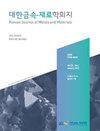Properties of Y2O3 Dispersion Strengthened W Fabricated by Ultrasonic Spray Pyrolysis and Pressure Sintering
IF 1.4
4区 材料科学
Q4 MATERIALS SCIENCE, MULTIDISCIPLINARY
引用次数: 0
Abstract
The effects of fabrication method on the microstructure and sinterability of W-1 wt% Y2O3 were analyzed. W composite powders dispersed with Y2O3 particles were synthesized by the ultrasonic spray pyrolysis process or the ultrasonic spray pyrolysis/polymer solution process. A dense composite was fabricated by a combination of spark plasma sintering and final hot isostatic pressing. The powder synthesized by the ultrasonic spray pyrolysis had fine dispersed particles on the surface of the cubic powder and was composed of W, Y2O3 and W-oxides. On the other hand, in the case of the ultrasonic spray pyrolysis/polymer solution process, the nano-sized particles formed agglomerates and existed only as pure W and Y2O3 phases. All the sintered compacts treated with HIP showed an increase in relative density, and the sintered compacts of the powder synthesized by the ultrasonic spray pyrolysis/polymer solution process showed a maximum relative density of 97~99% and a fine grain size. The change in microstructure with different powder processing was explained by the presence of W-oxide and the size and distribution of Y2O3 particles. The Vickers hardness of the sintered compact reached the largest value of about 5 GPa in the powder synthesized by the ultrasonic spray pyrolysis/polymer solution process, which was interpreted to be a result of the relatively high density and decreased grain size.超声喷雾热解-压力烧结制备Y2O3弥散增强W材料的性能
分析了制备方法对W-1 wt% Y2O3的显微组织和烧结性能的影响。采用超声喷雾热解或超声喷雾热解/聚合物溶液工艺制备了分散在Y2O3颗粒中的W复合粉体。采用火花等离子烧结和末热等静压相结合的方法制备了致密复合材料。超声波喷雾热解制备的粉体在立方粉体表面具有细小的分散颗粒,主要由W、Y2O3和W-氧化物组成。另一方面,超声波喷雾热解/聚合物溶液工艺中,纳米级颗粒形成团聚体,仅以纯W和Y2O3相存在。经HIP处理后的烧结体相对密度均有所增加,超声喷雾热解/聚合物溶液法制备的粉体烧结体相对密度最大可达97~99%,晶粒尺寸较细。w -氧化物的存在以及Y2O3颗粒的大小和分布可以解释不同粉末处理过程中微观结构的变化。超声喷雾热解/聚合物溶液法制备的粉末烧结体的维氏硬度最大,约为5 GPa,这可以解释为烧结体密度较高,晶粒尺寸减小的结果。
本文章由计算机程序翻译,如有差异,请以英文原文为准。
求助全文
约1分钟内获得全文
求助全文
来源期刊

Korean Journal of Metals and Materials
MATERIALS SCIENCE, MULTIDISCIPLINARY-METALLURGY & METALLURGICAL ENGINEERING
CiteScore
1.80
自引率
58.30%
发文量
100
审稿时长
4-8 weeks
期刊介绍:
The Korean Journal of Metals and Materials is a representative Korean-language journal of the Korean Institute of Metals and Materials (KIM); it publishes domestic and foreign academic papers related to metals and materials, in abroad range of fields from metals and materials to nano-materials, biomaterials, functional materials, energy materials, and new materials, and its official ISO designation is Korean J. Met. Mater.
 求助内容:
求助内容: 应助结果提醒方式:
应助结果提醒方式:


